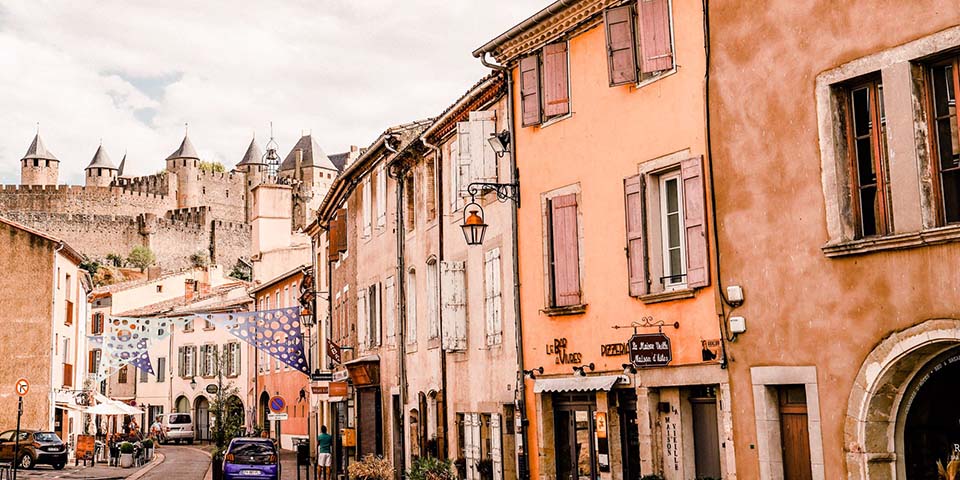
The first time I saw the magnificent medieval French town of Carcassonne was on a grey and dismal day one December. I was driving, rather aimlessly I admit, from Northern Spain towards the French town of Narbonne. This might seem an unlikely destination but, in those days, Narbonne was a Motorail terminal where you could put your car on the Motorail train to Paris and then take the TGV (Train à Grande Vitesse) sleeper train to Paris where magically, you’d meet your car the following morning. It saved a lengthy trek through France and as a bonus, the company also washed the car. Sadly, this wonderful service is much diminished, though I believe the Motorail trains still run from Paris to various destinations in the South of France. Incidentally, there used to be an extensive Motorail service in Britain. It began back in 1955 and remained popular until the early 1990s though many routes operated at a loss. When British Rail was privatized in 1995 the whole thing was closed down. But I digress. (So what’s new? – Ed.)
The fortress of Carcassonne is an impressive sight even in the bleak mid-winter (to quote Christina Rossetti). This ancient town, with its castle-like double walls, majestic turrets and jumble of stone buildings sits among a vast ocean of vines, for it lies near the middle of the Languedoc wine-growing region. It’s the single biggest wine-producing region in the world. But in December, nothing much happens in the vineyards. Nothing much at all, for you see, the vines are virtually hibernating.
I mention Carcassonne because it’s the home of the wine company LGI, which was founded over twenty years ago and has since developed expertise in sourcing wines from both Gascony and the Languedoc. It produces some fascinating wines too, including the Rare Vineyards collection of budget wines that feature unconventional wines from familiar regions. This is one of them.
Rare Vineyards Sauvignon Blanc (white), IGP Côtes de Gascogne, France (Bt. 650 @ Wine Connection)
You’ve heard about Sauvignon Blanc often enough. But the Côtes de Gascogne? Well, in case you’ve forgotten (or possibly never knew) it’s a wine-growing district in the old French region of Gascony. It lies on the Atlantic side of France and stretches from Bordeaux right down to the Spanish frontier and the mountains of the Pyrenees. Strangely enough, although most of its neighbours produce red wines, the Côtes de Gascogne produces mostly whites – around 91% to be exact. These are made from a variety of grapes, notably Colombard, Sauvignon Blanc, Sémillon and Muscadelle. They also grow a few oddly-named local varieties such as Petit Manseng and Gros Mansen along with Ugni Blanc, probably better known by its Italian name, Trebbiano.
This Sauvignon Blanc (SOH-vihn-yohn BLAHN) is a pale straw colour with an extraordinary rich, fruity aroma of pear, peach and melon. There’s a delicate hint of boiled sweets and a touch of grassiness too. But the aroma alone is worth the money. It carries a faint mineral character too, which is not altogether surprising, because this is typical of Sauvignon Blanc.
 The taste comes as quite a surprise. It’s much fuller and richer than I expected, with loads of fruit on the palate and a lovely dry tang of acidity. The taste fairly fills the mouth and there’s an exceptionally long, clean and lemony dry finish. This would make a terrific apéritif because the sprightly touch of grapefruit-like acidity would kick the taste buds into anticipation. This wine has plenty of Sauvignon Blanc character but more intense than most Sauvignons I have come across recently. I think it would make a great partner for roast chicken or a rich and fully-flavoured cheese quiche.
The taste comes as quite a surprise. It’s much fuller and richer than I expected, with loads of fruit on the palate and a lovely dry tang of acidity. The taste fairly fills the mouth and there’s an exceptionally long, clean and lemony dry finish. This would make a terrific apéritif because the sprightly touch of grapefruit-like acidity would kick the taste buds into anticipation. This wine has plenty of Sauvignon Blanc character but more intense than most Sauvignons I have come across recently. I think it would make a great partner for roast chicken or a rich and fully-flavoured cheese quiche.
30 Mile Shiraz (red), S E Australia (Bt. 690 @ Wine Connection)
Sunny South East Australia is almost the climatic opposite of Gascony and this Shiraz (SHEE-raz) really looks the part; a rich, dark crimson with hints of purple and a slightly oily appearance, which always seems to me a good sign. The aroma is quite complex. Rich black cherries, spices and fresh pepper come through first. If you really concentrate you might pick up wine gums and raspberry jam. I thought I could pick up a faint whiff of licorice too. Open the bottle about half an hour in advance, so that the wine has a chance to reveal its aromatic secrets. A bit of aeration usually helps hearty wines like this one.
The wine showed every sign of being a turbo-charged Shiraz and I was expecting it to hit the palette like a torpedo. To my surprise and delight, it has a beguiling gentle touch. The wine is dry of course, but has a soft, almost silky mouth-feel and a satisfying smooth foundation of tannin with beautifully balanced fruit flavours. There’s a lovely long and soft, dry cherry finish too. Needless to say, this wine demands hearty fare, so save it for rich flavorful dishes or the weekend barbeque, if you still have them.
30 Mile wines are produced by John Quarisa, best known for his Johnny Q label. This wine is a real beauty, and if you like a bold, luscious Australian Shiraz give this a try. You will not be disappointed. Neither were the wine professionals, for it has already won several prestigious awards.
 |
 |
 |





